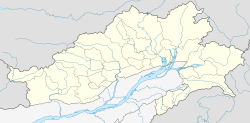Tawang town
|
Tawang तवांग རྟ་དབང་ |
|
|---|---|
| Town | |

Tawang with Tawang Monastery in background
|
|
| Location in Arunachal Pradesh, India | |
| Coordinates: 27°35′18″N 91°51′55″E / 27.58833°N 91.86528°ECoordinates: 27°35′18″N 91°51′55″E / 27.58833°N 91.86528°E | |
| Country |
|
| State | Arunachal Pradesh |
| District | Tawang |
| Government | |
| • Type | Municipal corporation |
| • Body | Nagar Palika |
| Elevation | 2,669 m (8,757 ft) |
| Population (2011) | |
| • Total | 11,202 |
| Time zone | IST (UTC+5:30) |
| Vehicle registration | AR |
| Climate | Cwb |
Tawang is a town situated at an elevation of approximately 3,048 metres (10,000 ft) to the east of Bhutan. The area is administered by the Arunachal Pradesh of Republic of India and is claimed by People's Republic of China as a part of South Tibet, under Cona_County of Tibet. The town once served as the district headquarters of West Kameng district, and became the district headquarters of Tawang district when it was formed from West Kameng.
Tawang was historically part of Tibet inhabited by the Monpa people. The Tawang Monastery was founded by the Merak Lama Lodre Gyatso in 1681 in accordance with the wishes of the 5th Dalai Lama, Ngawang Lobsang Gyatso, and has an interesting legend surrounding its name, which means "Chosen by Horse". The sixth Dalai Lama, Tsangyang Gyatso, was born in Tawang.
The 1914 Simla Accord defined the McMahon Line as the new boundary between British India and Tibet. By this treaty Tibet relinquished several hundred square miles of its territory, including Tawang, to the British, but it was not recognised by China. The British records show that there are conditions for the Tibetan government to accept the new border in 1914, the condition was that China must accept the Simla Convention, since the British was not able to get an aceptance form China, Tibetans considered the MacMahon line invalid. The British did not take possession of Tawang and Tibet continued to administer and collect taxes in Tawang. When the British botanist Frank Kingdon-Ward crossed the Sela Pass and entered Tawang in 1935 without permission from Tibet, he was briefly arrested. The Tibetan government lodged a formal complaint against Britain. This drew the attention of the British, who re-examined the Indo-Tibetan border and rediscovered that Tibet had ceded Tawang to British India, and attempted to revive the McMahon Line, in November, the British government demanded Tibet to implement the 1914 Simla Accord , this met with rejection from the Tibetan government which rejected the validity of the McMahon Line. Tibet did not repudiate the Simla Accord and the McMahon Line, but refused to surrender Tawang, partly because of the importance attached to the Tawang Monastery. In 1938 the British made a cautious move to assert sovereignty over Tawang by sending a small military column under Capt. G.S. Lightfoot to Tawang. The invasion was met with strong resistance from the Tibetan government and local people, a serious protest was lodged against the British Indian government.
...
Wikipedia


